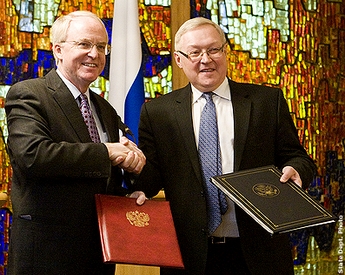On 11 January, U.S. Ambassador to Russia John Beyrle and Russian Deputy Foreign Minister Sergey Ryabkov exchanged diplomatic notes to bring into force the Agreement between the Government of the United States of America and the Government of the Russian Federation for Cooperation in the Field of Peaceful Uses of Nuclear Energy, also known as the U.S.-Russia 123 Agreement.

U.S. Under Secretary for Political Affairs Bill Burns signed the 123 agreement with Rosatom Director General Sergey Kiriyenko on 6 May 2008, during his tenure as U.S. Ambassador to Russia, but the deal was delayed, probably due to concerns about Russia's crackdown on Georgia.
In reaction to signing the agreement, Russian president Dmitry Medvedev said that Russia and the USA should avoid politicising nuclear cooperation. "It's a good job. The main thing is that it is not politicised, but to do [it] like a business."
The 123 Agreement will allow cooperative work on reactor designs that result in reduced proliferation risk. It creates the conditions for advanced research and development projects that partner U.S. national laboratories and industry with Russian partners to explore areas including fuel fabrication, innovative fuel types, and advanced reactor design.
The 123 Agreement supports American and Russian commercial interests by allowing companies to team up more easily in joint ventures, and by permitting sales of U.S. nuclear material and equipment to Russia. This will put the United States and Russia’s nuclear relationship on a stronger commercial footing. U.S. firms will be able to develop advanced nuclear reactors, fuel-cycle approaches, and cutting-edge technology with Russian partners that are safe, secure, and reliable.
The 123 Agreement creates the conditions for improved cooperation on joint technology development to support arms control and nonproliferation activities. It will also provide the necessary legal framework for joint efforts to convert research reactors from highly-enriched uranium to low enriched uranium fuel. The 123 Agreement will aid cooperation on forensic analysis, allowing us to better identify nuclear material and prevent it from getting into the hands of terrorists, and it sets the stage for expanded joint technical cooperation on next generation international safeguards.
Russian government panellist Bateau Zhargal Zhambalnimbuev said, "It gives us real access to the U.S. market, will increase the volume of deliveries of low enriched uranium for U.S. stations. Already, [through] the HEU-LEU, we supply 40% of low-enriched uranium to the U.S. market. However, the HEU will soon end, and to lose such a market, as America, would be very imprudent."
Related ArticlesAgreement extends Paducah enrichment operations Usec reports huge loss for 2012




